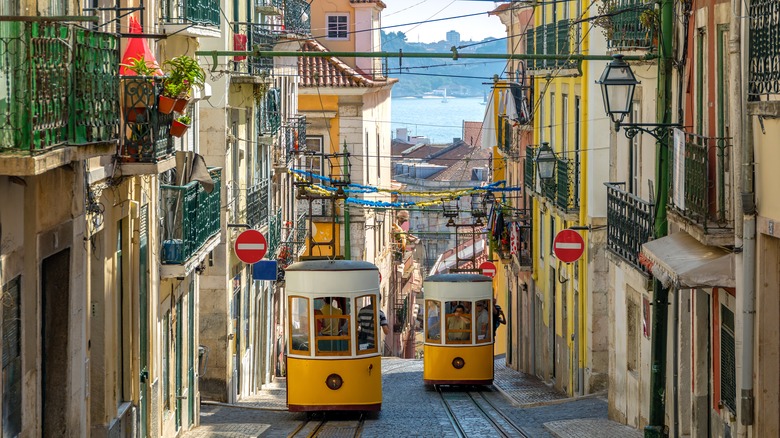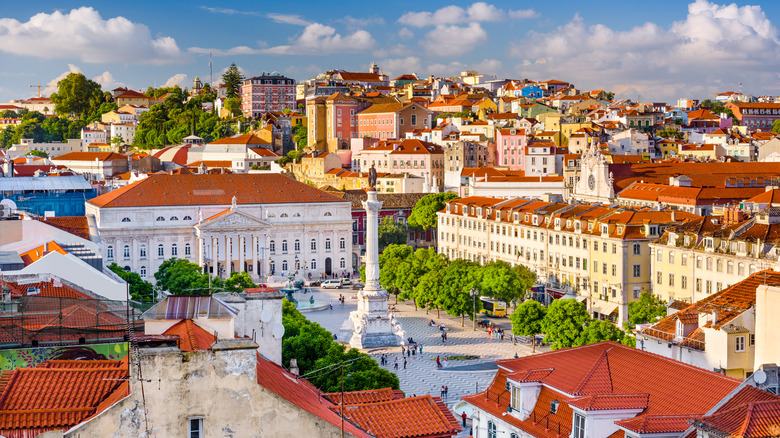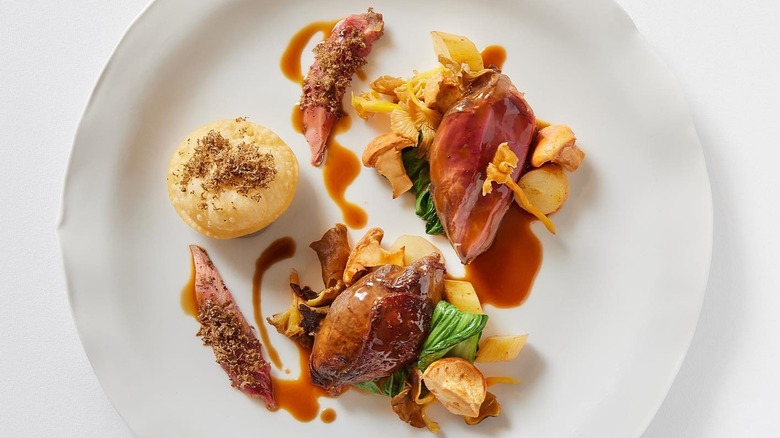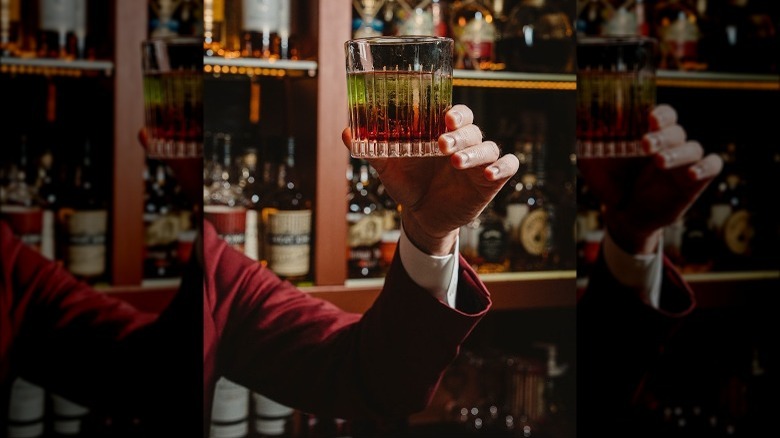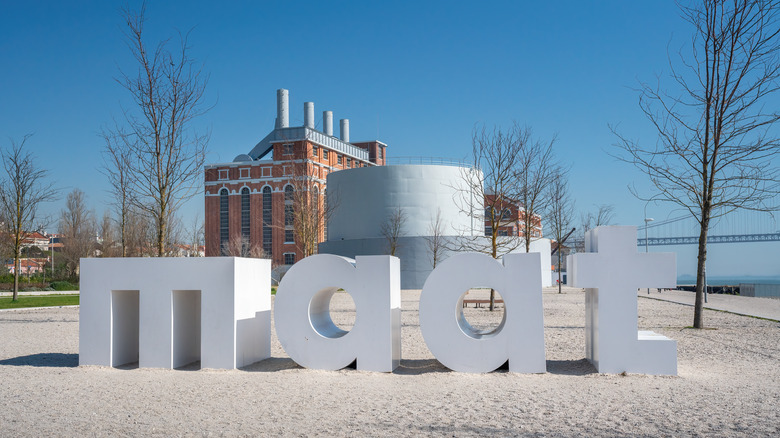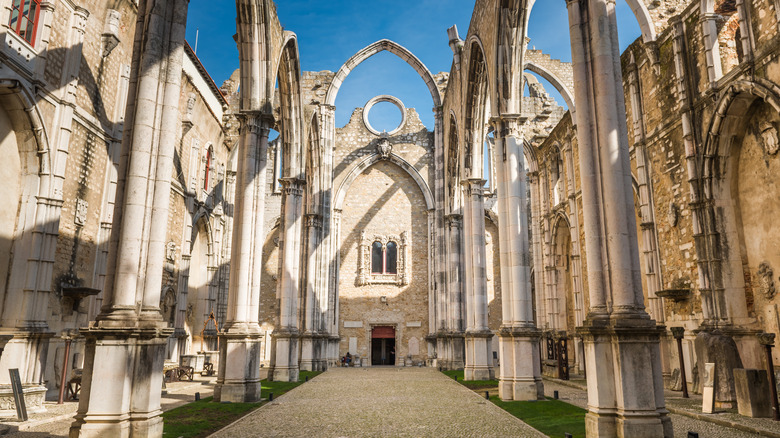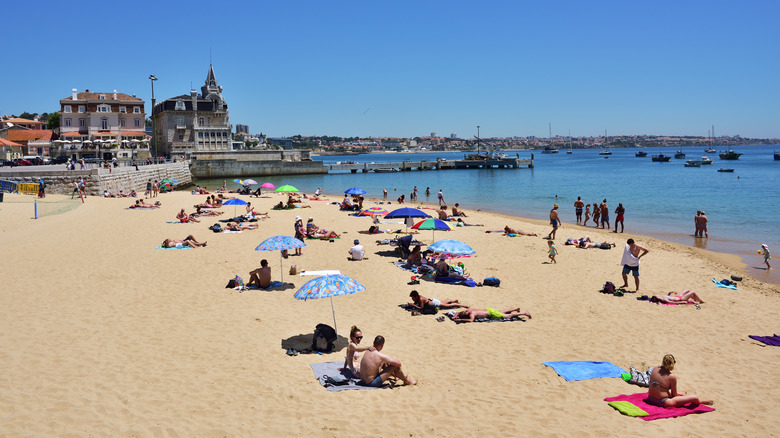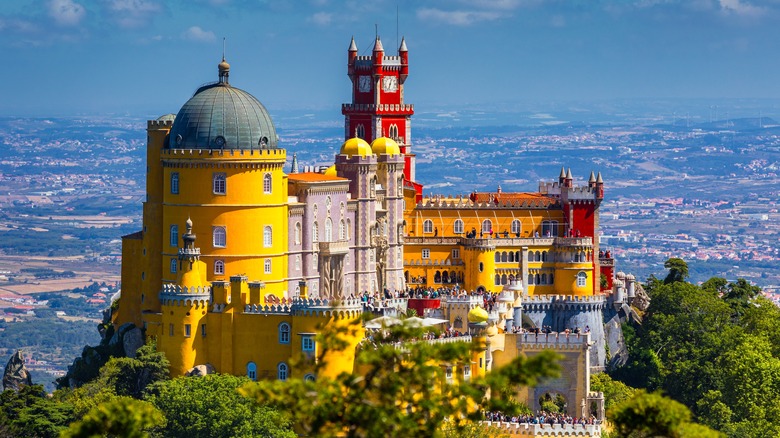Lisbon Is 2023's Best European City For Short Getaways: Here's How To Plan A Trip
When folks think of the best European cities for budget travelers, Eastern capitals like Sofia, Bulgaria or Budapest, Hungary often come to mind. However, the most affordable city for a short getaway in 2023 is actually Lisbon, Portugal. Every year, the UK's Post Office Travel Money runs a survey of how much 12 typical tourist expenses (including a two-night stay in a three-star hotel and sightseeing entry fees) cost in 35 European cities to compile its annual City Costs Barometer. The ranking has been around for 16 years and for the first time ever, the usual winners from Eastern Europe were overthrown by the Portuguese capital. Indeed, when Money ran a similar survey to find the top affordable travel destination for 2023, Lisbon won out again thanks to its affordable accommodations, budget-friendly airfare, great value dining, and varied excursions.
Whether you've thought of visiting Lisbon before or haven't really considered it, the city certainly deserves a spot on your travel wish list. After all, it has plenty to offer all types of travelers. There are Michelin-starred restaurants and top-rated bars for those seeking a culinary vacation, plenty of UNESCO-certified cultural sites, beautiful sun-filled beaches, and everything in between. Here's how to plan the perfect short (or long!) getaway to, as the locals call it, Lisboa.
Where to stay in Lisbon
When choosing the right area to stay in, we recommend honing in on Lisbon's city center, especially if you're planning a shorter trip. That way you can easily walk to attractions, restaurants, and shops or hop onto the subway, bus, or tram at a central stop to visit further afield. First up, there's Baixa, one of the most popular tourist areas in Lisbon. The pedestrian Rua Augusta, which runs through its core from Rossio down to the waterfront at Praça do Comércio plaza, is in the heart of the action and is filled with outdoor cafes, restaurants, and shops. Equally popular is the Bairro Alto/Chiado area which has been compared to Paris' Montmartre. Alternatively, you may prefer to stay in Alfama, the city's oldest neighborhood, or at one of the swanky hotels lining the Avenida da Liberdade, which is essentially the Champs Élysées of Lisbon.
There are plenty of accommodations to choose from in each of these areas but some top-rated options include Brown's Central Hotel in Baixa, just a stone's throw from the famous Santa Justa Lift; the Instagram-ready AlmaLusa Baixa/Chiado housed in an 18th-century building; the luxurious Sofitel Lisbon Liberdade and BessaHotel Liberdade; and Memmo Alfama Hotel Lisboa, a top-rated design hotel inside a building dating back to the 1800s, which was once a shoe factory.
Tip: Ride the entire route on the vintage 1930s yellow Tram 28 (about 50 minutes) for a cheap DIY tour of the city's top sights.
Treat yourself to delicious cuisine at Lisbon's best restaurants
Lisbon may be famous for its sardinhas (sardines) and bacalhau (salted cod), but its culinary scene extends far beyond these staples. Foodies will find countless reasons to rejoice as they explore the city's exciting food scene. Indeed, Lisbon is home to a surprising number of celebrity chefs, an impressive list of Michelin-starred venues, and plenty of local eats that simply can't be missed. If you're looking to splurge on a memorable dinner, there's the one-starred 100 Maneiras from Serbian chef Ljubomir Stanisic, the two-starred Belcanto from local powerhouse José Avillez, and the two-starred Alma from celeb chef Henrique Sá Pessoa. However, if you'd like to stick to a tighter budget, these culinary greats also have casual, lower-priced outlets, like Stanisic's Mexican gastrobar, Carnal, and Avillez's very own food hall, Cantinho do Avillez. Another recognizable name is Kiko Martins who has played host to Gordon Ramsay and whose goop-approved A Cevicheria serves up truly mouth-watering ceviches.
Then there are the local haunts. Head to Lisboa Tu & Eu or A Taberna da Rua das Flores for sardines, El-Rei Dom Frango for fresh seafood – try the octopus! – or A Casa do Bacalhau for a wide selection of varied cod dishes. No visit would be complete without trying a bifana, Lisbon's traditional pork sandwich, at the Anthony Bourdain-approved O Trevo or a flaming chourico assado (sausage served in a clay dish and set on fire before your eyes) at bar Tasca do Chico.
Track down the best pastéis de nata in town
Whether you have a sweet tooth or not, Portugal's famous custard tarts, called "pastéis de nata," will steal your heart. Made of a flaky crust filled with gorgeous yellow egg custard and baked to perfection, these little treats can be eaten in just a couple of bites, and stopping at one is a struggle. It's believed that these yummy creations were first invented in the 18th century by monks at the Mosteiro dos Jerónimos (Jerónimos Monastery) in Belém (which, incidentally, you can visit during your trip) and their popularity hasn't waned since. These days, it's hard to walk more than a few blocks in Lisbon without coming across a shop selling hot tarts straight from the oven.
Just a few top options include Pastéis de Belém, which opened its doors in 1837 and is still using the ancient recipe from the monastery. There's usually a long line, but it's worth the wait. If you opt for takeout, make sure to pop into the restaurant to see how the tarts are made. There are also the less crowded Manteigaria and Fábrica da Nata, both of which have several outposts around the city. If you choose the latter, you can pair your tart with a glass of port for just 3.90€ (about $4). Alternatively, you can visit Pastelaria Alcoa, which opened in 1957 and serves a long list of tasty confections. Or, travel back in time at Confeitaria Nacional, which hasn't changed much since 1829.
Visit one of the city's top-rated bars
Not only does Lisbon offer a long list of culinary delights, it also boasts an impressive bar scene serving up cocktails, craft beers, and local wines. One of the most popular bars in the city right now is Red Frog, which has been on The World's 50 Best Bars list three times, so far. Reservations are a must at this speakeasy which you enter by ringing a bell mounted underneath (what else?!) a red frog. Inside, you'll find classic cocktails, as well as unexpected twists, like the Peanut Old Fashion (bourbon, coffee, cocoa bitters, and peanuts) or Salty Dog (vodka, pink pepper, and grapefruit soda). A newer but equally lauded addition to the list is Quattro Teste, a Basque/Italian locale serving delicious, Instagram-ready cocktails, like the Nuclear Melon-Pesto Margarita and Espresso Livornese made with rum and cold brew. Also notable is the quirkiest bar in town, Pavilhão Chinês, which looks like a curiosity shop packed with antiques from floor to ceiling. Be sure to say hi to the life-sized mannequin wearing a British royal guard uniform!
But it's not all about cocktails. Wine lovers will enjoy By the Wine where you can choose from about 80 wines and pair them with tasty tapas. If you're more into beer, there's Outro Lado with its dozen draft beers and 400 bottled labels, as well as Duque Brewpub, Lisbon's very first brewpub, which boasts 50 bottled labels and nine taps dedicated to Portuguese craft beers.
Take in culture at Lisbon's varied museums
Lisbon's museums may not be as widely known as those in other European capitals, like Paris or London, but the city has plenty to offer when it comes to culture. Start off by learning about two of Portugal's most distinctive art forms at the Museu Nacional do Azulejo (National Tile Museum), dedicated to the iconic ceramic tiles, and the Museu do Fado (Fado Museum), which traces the history of this unique musical style born in Lisbon 200 years ago. The Museu Nacional dos Coches (National Coach Museum) is also a show-stopper showcasing opulent royal coaches dating back to the 17th century, many of them dripping with gold.
If you're interested in more traditional art, there's the incredible 6,000-piece private art collection at the Museu Calouste Gulbenkian, which ranges from Egyptian pieces to paintings by greats like Edgar Degas, Peter Paul Rubens, and Pierre-Auguste Renoir. Similarly, the Museu Medeiros e Almeida displays an impressive 2,000-piece private collection of decorative arts inside the grand home of the Medeiros e Almeida couple, just off the Avenida da Liberdade. As for one of the most unusual museums in the city, there's the Museum of Art, Architecture and Technology (MAAT), which comprises two spaces – MAAT and Central – hosting a variety of temporary exhibitions. The latter is especially interesting because it is housed inside Tejo Power Station, a restored thermoelectric power plant that was in service through the early 1970s. Walk through the huge space and learn about electricity while being wowed by the historic machinery.
Visit some incredible historic ruins
Among Lisbon's most popular historic attractions are two unmissable outdoor sites: the Castelo de São Jorge and Museu Arqueológico do Carmo (Carmo Convent). The castle, perched atop Lisbon's tallest hill, can be reached on foot, but if you'd rather avoid the steep uphill climb, you can hop onto Tram 28 or take bus 737 at Praça da Figueira, which drops you off at the main gate. The castle's history traces back to the Romans in 200 BC, but the fortress walls you see today are remnants of Moorish rule, which began in 700 AD. As for the royal palace, it was erected after the Portuguese king, Afonso Henriques, won the city back in the 1100s. Today, you can see remnants of the palace, climb up one of 10 intact turrets, walk around the fortress walls, and learn about the site's history at the museum center. Get ready for incredible city views and don't forget to walk through the gardens to say hello to the peacocks!
Another highlight is the ruins of Carmo Convent. Built in 1389 on the hill opposite Castelo de São Jorge, the convent was destroyed in the 1755 earthquake and subsequent fire. Reconstruction started, stopped, then it was decided that the church would stay as is, with its roof missing and its nave open to the sky. There's also a small archeological museum boasting a varied collection that includes the tomb of King Ferdinand I, an Egyptian sarcophagus, and two pre-Columbian mummies from Peru.
Soak up the sun at a nearby beach
When you think of Portugal, you likely think of fun in the sun and no trip would be complete without soaking up some rays at the beach. Luckily, you don't have to go very far to find access to water. In fact, you can dip your toes in the Tagus River right off the Praça do Comércio if you want. However, if it's sand and leisure you're after, you can easily access Praia de Carcavelos or Praia de Ribeira by public transit. Both are a direct 40-minute train ride from the central Cais do Sodré station.
The first boasts pristine golden sand (perfect for sunbathing!), plenty of restaurants and bars, and facilities for outdoor sports. However, the water is always pretty brisk and wavy, which explains why surf lessons are popular here. Alternatively, if you have your heart set on swimming, opt for the scenic Ribeira beach in Cascais. This picturesque resort town has been visited by everyone from Grace Kelly to Pablo Picasso and has plenty to see, do, and eat. At its heart is the old fishermen's beach, Ribeira, where you can enjoy the calm waters surrounded by pretty views and moored fishing boats. Do note, though, that this spot is popular with both locals and tourists alike.
Tip: If you're tight on time, consider Algés Beach. As the closest beach to the city center, it's just a 20-minute walk from Belém Tower.
Hop on the train for an easy day trip
Lisbon is perfectly positioned for a quick and easy day trip. As mentioned above, Cascais is a 40-minute train ride away and offers beaches, fresh seafood, shopping, and a number of small museums. The picturesque Casa de Santa Maria (the 1902 mansion of an aristocrat) and adjacent blue and white lighthouse are standouts. Then there's Évora, accessible by train in an hour and a half, whose historic center has been designated by UNESCO. The city oozes history with its Roman temple, main Cathedral dating back to the 1200s, and Roman baths. There's one unusual breathtaking attraction that really sets this town apart, though. Inside Igreja de São Francisco (Church of St. Francis), you'll find the eerie chapel of bones. Built by Franciscan monks in the late 16th century, this chapel is covered in skulls and bones from floor to ceiling and is certainly not for the faint of heart.
However, the most popular day trip – hands down – is Sintra. Just 40 minutes by train from Rossio, the city is home to numerous UNESCO-recognized sites, including the Castelo dos Mouros, Palacio Nacional Sintra, and Quinta da Regaleira. But it's the colorful Palacio da Pena that steals the show. With its yellow, blue, and red facade, the instantly recognizable landmark is an Instagram staple, and it's just as impressive on the inside. Enter the former home of King Ferdinand II and be amazed by the opulence of every room, from the bedroom to the kitchen.
Enjoy a night of live Fado music
Fado music was born in Lisbon in the 1800s and is so special it was actually added to UNESCO's list of Intangible Cultural Heritage of Humanity. It's usually performed by one singer accompanied by a number of guitars and the words, infused with melancholy, typically focus on the hardships faced by everyday people. If you'd like to learn about the history of this art form, as well as its most famous performers, you can visit the Museu do Fado, but nothing beats actually hearing it live. Attending a fado show will give you a real understanding and appreciation for this unique type of music.
There are numerous places to see this craft first-hand, although some can be quite expensive and overly touristy. A few top-rated options include Casa de Linhares, located inside an old Renaissance mansion in Alfama. Here, you can enjoy dinner by candlelight accompanied by a show. Another option is Povo in Cais do Sodré which serves fresh seasonal dishes paired with local wines and hosts fado every night between 8 p.m. and 11:30 p.m. Finally, there's Mesa de Frades, which has taken over a former chapel in Alfama. Marvel at the 18th-century azulejo tiles as you dig into Portuguese fare and listen to fado performed by young and seasoned artists.
Master some basic Portuguese phrases
While you shouldn't have any issues communicating in English at Lisbon's most popular spots, it's always nice to know some basic phrases in the local language. Saying "hello" is as simple as "oi," although Babbel notes you can also tailor your greeting to the time of day. Use "bom dia" for "good morning," "boa tarde" for "good afternoon" and "boa noite" for "good evening." If you want to know how someone's doing, ask them "Como vai?" then let them know all is good with you with a "Tudo bem." How you say thank you will depend on if you're female – "obrigada" – or male – "obrigado" while saying "bye" is as quick as "tchau" or "tchau, tchau."
Some other simple phrases you may find handy while traveling in Portugal include "Quanto custa?" ("How much does it cost?") and "A continha, por favor" ("The bill, please.") If you're asking for directions, know that "esquerda" means the left while "direita" means the right. "Onde é o banheiro?" will help you find the restroom while replacing the last word with "estação de metrô" or "estação de trem" will guide you to the nearest metro or train station, respectively. Last but not least, two more valuable phrases to master are "Você fala Inglês?" ("Do you speak English?") and "Eu não entendo" ("I don't understand"). Happy travels!
